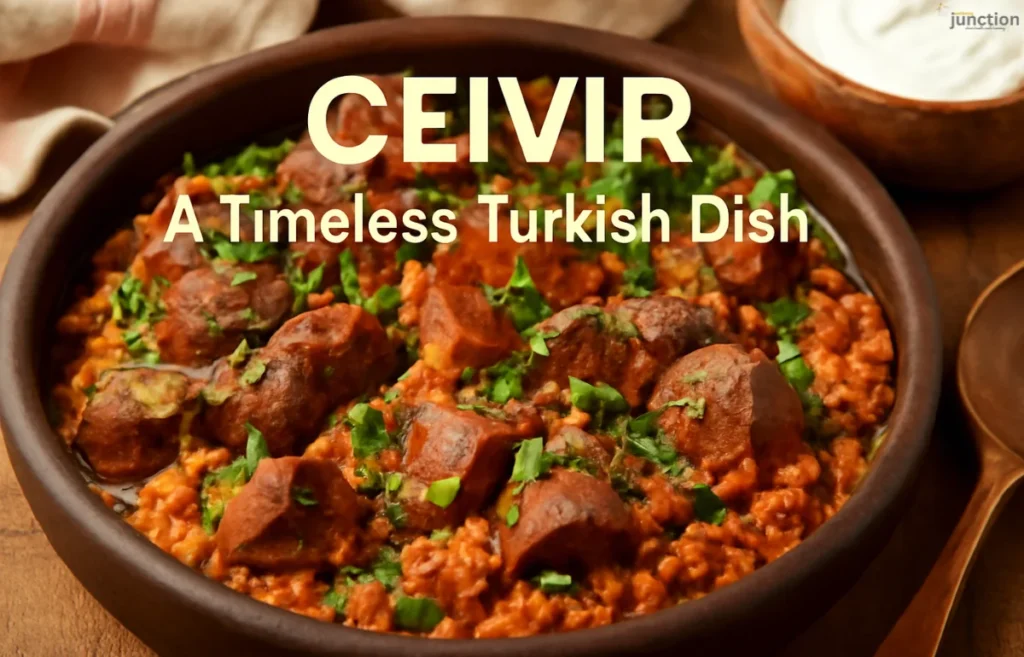Imagine a meal that carries the weight of history, a dish born from resourcefulness and community, yet remains entirely relevant in the modern kitchen. That meal is Ceıvır—a traditional and significant Turkish creation that, despite its deep roots, remains largely unknown outside of its native Anatolian lands. More than just sustenance, Ceıvır is a cultural tapestry woven from basic ingredients: meat, grains, vegetables, and aromatic spices. It’s a flexible, hearty blend that speaks volumes about the region’s past, and it’s high time this culinary emblem took its rightful place on the global stage.
The Deep Roots of Ceıvır in Anatolian History
To truly appreciate Ceıvır, you must trace its origin back to the ancient Anatolian heartland. This dish didn’t emerge from a royal kitchen, but from the necessities of nomadic and agrarian life. Early communities required meals that could be prepared efficiently with local, seasonal produce, feed many people, and adapt to long journeys or periods of scarcity.
Nomadic Origins and Resourcefulness
The earliest iterations of Ceıvır likely focused on the simplest staples: grains (like cracked wheat or bulgur), legumes, and meat from livestock. The technique of slow-cooking these components together allowed meager amounts of protein to stretch, while the use of broth and fat ensured a high-calorie, sustaining meal. This resourceful approach turned a few simple components into a profound culinary statement—a testament to resilience.
A Symbol of Hospitality and Community
Over centuries, Ceıvır transitioned from daily sustenance to a marker of cultural identity. It became a fixture at festivals, celebrations, and, most importantly, on the table offered to guests. Serving a deeply satisfying portion of Ceıvır is a significant act of Turkish hospitality, signaling honor, belonging, and respect for tradition. When you taste this dish, you are not just eating food; you are partaking in a shared memory passed down through generations.
Deciphering the Core Components of Authentic Ceıvır
While the exact recipe for this one-pot meal shifts dramatically across provinces, the structural logic of traditional Ceıvır remains consistent. It balances nourishment, texture, and flavor through careful layering of core ingredients.
The Protein and Fat Base
Traditionally, lamb or beef forms the meat component. Cooks often prefer bone-in cuts to enrich the final dish with deep, savory flavor and natural gelatin. The meat is typically seared or slow-cooked in olive oil or rendered animal fat until exceptionally tender. In coastal regions, lighter proteins like poultry or even fish might be substituted, but the richness of red meat defines the classic preparation.
Grains: The Anchoring Element
The choice of grain provides the dish’s essential structure and ensures a satisfying, hearty texture. Bulgur is arguably the most traditional choice, offering a wonderful chewiness and nutty flavor that perfectly absorbs the meat juices and broth. However, rice is also common, particularly in refined versions where a softer mouthfeel is desired. This grain base is what truly makes Ceıvır a balanced, complete meal.
Spices and Aromatics
The flavor profile of Ceıvır is defined by its thoughtful spice blend, which aims to support the core ingredients, not overpower them. Cumin, paprika (often smoked), and black pepper are foundational. Regional cooks may introduce subtle warm notes with a touch of allspice or cinnamon, or add a delightful tang using sumac. Aromatics like onion, garlic, and tomato paste provide the necessary acidic and savory foundation.
The Finishing Touch: Freshness
A truly great Ceıvır is always completed with a bright contrast. Chopped fresh herbs—most commonly parsley, mint, or dill—are stirred in at the very end to preserve their volatile oils and provide a pop of green freshness. It is typically served with a dollop of cool, plain yogurt and a squeeze of lemon to cut through the richness.
The Diverse Faces of Ceıvır Across Turkey
One of the most compelling aspects of this Turkish cuisine staple is its incredible flexibility. As recipes traveled across the vast geographic and climatic expanse of Turkey, they adapted, leading to distinct regional variations of Ceıvır.
Eastern Anatolian Heartiness (Doğu Anadolu)
In the rugged, often colder eastern regions, the dish is predictably heartier. Lamb is emphasized, spices are bolder, and more fat is used. You might find preserved or dried vegetables incorporated, and the reliance on darker paprika gives the stew a richer color and depth of flavor. This interpretation is built to sustain long, cold days.
Aegean and Mediterranean Lightness (Ege ve Akdeniz)
Closer to the coasts, the influence of the Mediterranean diet lightens the approach. Olive oil becomes the dominant fat, and seasonal vegetables like eggplant or squash feature more prominently. The flavors are often brighter, with a heavy use of fresh mint, dill, and a greater emphasis on lighter meat cuts, making the coastal version feel fresher and slightly less dense.
Central Anatolian Density (İç Anadolu)
The central plateau often emphasizes the grain component. Here, you are most likely to encounter the denser, chewier bulgur-based Ceıvır. The spices are usually more restrained and impeccably balanced, allowing the natural flavor of the slow-cooked meat and locally sourced produce to shine through. The dish here is often substantial and foundational.
Mastering the Traditional Ceıvır Recipe
Preparing traditional Ceıvır is a labor of love that rewards patience. It is an ideal dish for those seeking to practice the slow craft of cooking. Success lies in deliberately developing the flavors step by step.
Preparation Technique: Layering Flavor
- Searing: The process begins by searing the meat (lamb or beef) in hot oil until deeply browned. This step is non-negotiable, as it builds the foundational umami flavor through the Maillard reaction.
- Sautéing: The meat is removed, and aromatics—onions, garlic, and bell peppers—are sautéed in the flavorful fat remaining in the pot. Spices are typically added next and toasted briefly to deepen their aroma.
- Slow Simmer: The meat is returned to the pot, covered with broth, and allowed to simmer, often for over an hour, until the meat is fork-tender. This action establishes the deep, flavorful broth.
- The Grain Factor: Once the meat is ready, the soaked bulgur or rice is stirred in. Liquid is adjusted, and the pot is covered to allow the grain to absorb the savory broth gently.
- Resting: A crucial, often overlooked step is resting. Allowing the one-pot Turkish dish to rest off the heat for 10–15 minutes allows the flavors to meld and the grain to achieve the perfect texture.
Evolving Ceıvır: Contemporary Trends and What’s Next
While the traditional method endures, contemporary Turkish chefs are creatively adapting Ceıvır. They are exploring vegan versions using hearty legumes or mushrooms as a protein substitute, incorporating ancient grains like farro or black rice, and experimenting with globally inspired infusions like pomegranate molasses. These modern interpretations respect the fundamental spirit of the dish—the combination of grain, protein, and spices—while demonstrating its endless culinary possibilities. This continual evolution ensures the heritage of Ceıvır remains alive and compelling for new generations of home cooks and food enthusiasts.
The Undeniable Appeal of Ceıvır: Why It Belongs in Your Kitchen
Ceıvır is more than just a recipe; it is a delicious reminder of how food can anchor us to identity, place, and history. It is a hearty, wholesome meal providing complex carbohydrates, quality protein, and essential nutrients. Whether you’re seeking a rich, comforting meal for your family or looking to explore the deeper, regional flavors of authentic Turkish cuisine, making Ceıvır is a culinary journey worth taking.
We encourage you to try your hand at preparing the classic version first to understand its balance. Then, feel free to explore your own regional twist, perhaps incorporating locally sourced vegetables or a unique spice blend. Discovering Ceıvır is discovering a profound piece of the world’s food heritage.
Ready to explore more complex, flavorful dishes from the Mediterranean and Anatolian regions? Why not look into the techniques used in preparing slow-braised Ottoman stews next?

I’m Salman Khayam, founder of Wellbeing Junction. I synthesize trusted information from research and expert guidance to create clear articles across health, wellness, and lifestyle topics.
Disclaimer: Content is for informational purposes only and is not medical advice. Consult a qualified expert regarding personal health or specialized questions.


